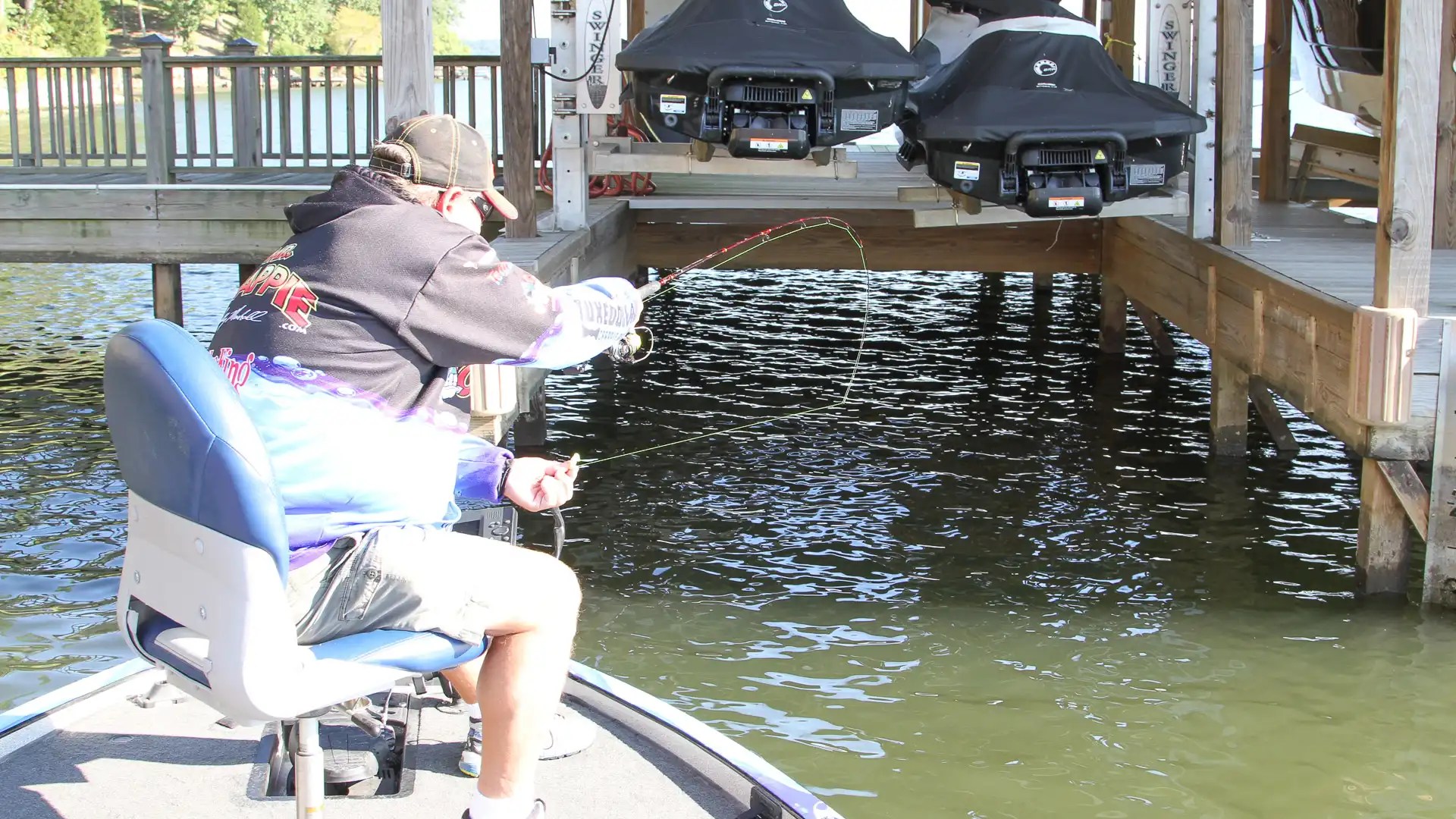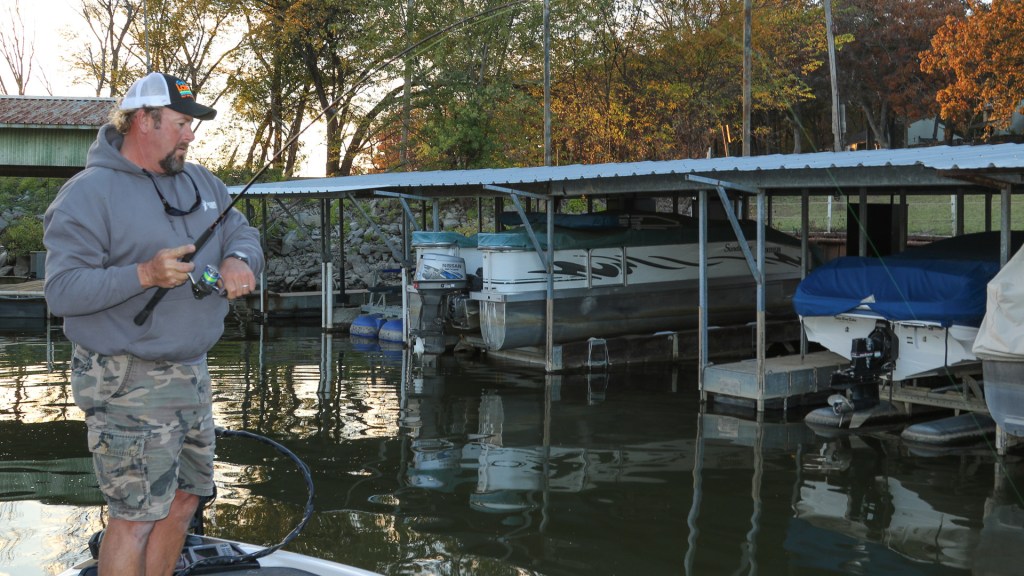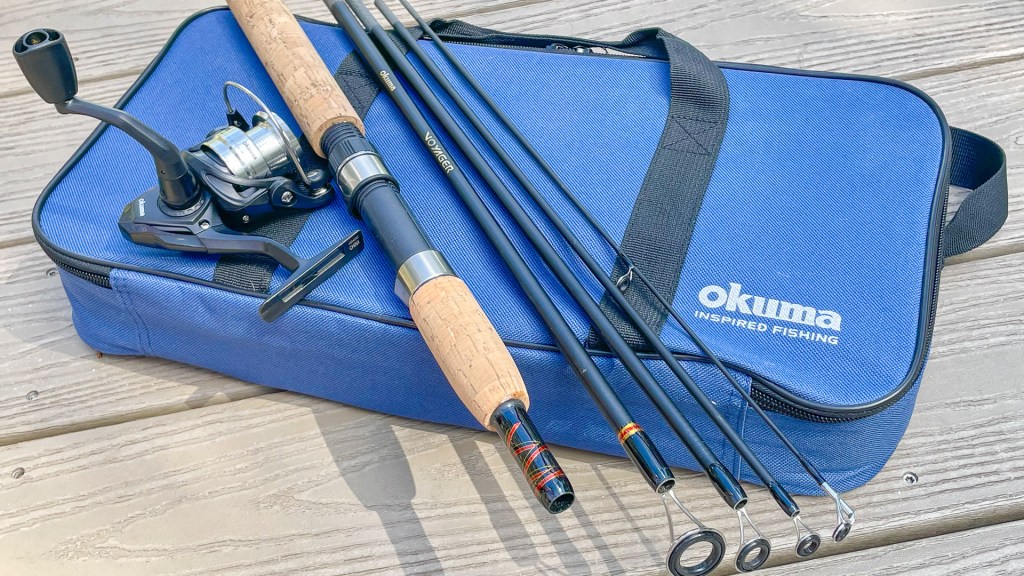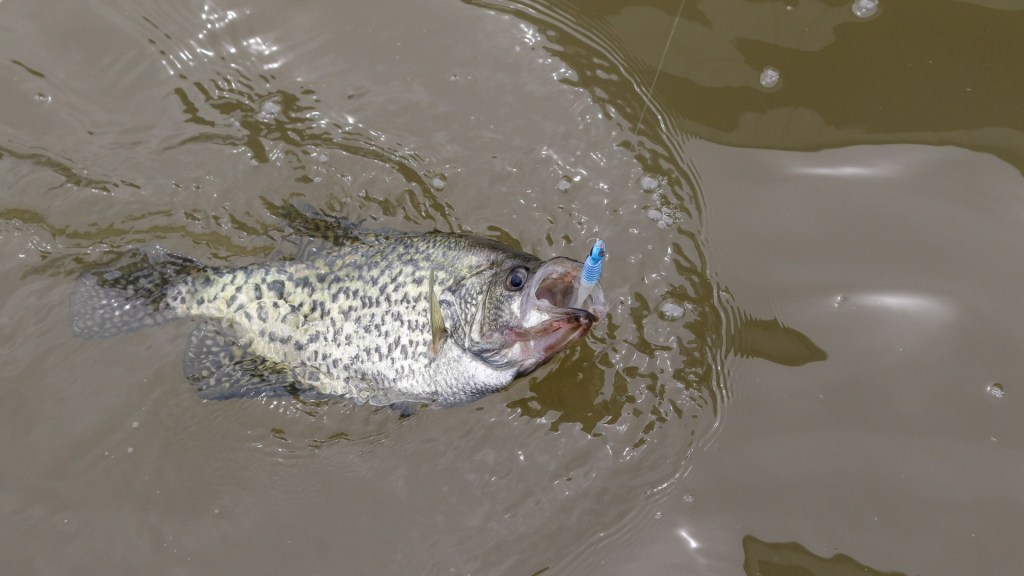
Crappie fishing used to be a simple, laidback, anyone’s kind of fishing. Then it became a highly competitive, technically advanced pursuit requiring high-end rods and reels, expensive electronics and multiple tackleboxes full of diverse baits and terminal tackle.
There’s nothing wrong with that, but not everyone’s into the sport that deeply. The fact is, a lot of folks are content to catch a handful of legal-size crappie and head home for a tasty dinner.
Here’s the good news: The days of simple, laidback crappie fishing have not left us. In fact, if you want a low-key path to rod-bending fun, the plan is simple: Take one medium spinning rod, a pack of light jigheads and a few different plastic body shapes/colors and find the closest dock.
With the exception of the spawn, when crappie may head to other habitat, docks with at least 6 feet of water below can harbor crappie almost any time. The warmer months are most productive, as crappie appreciate the shady cover, but with baitfish also huddling around docks, these feeding stations have broad appeal.
The best part about dock fishing is the access. From high-powered fiberglass bass boats to aluminum johnboats, canoes or kayaks, if you can find it, you can fish it.

Pick your targets
Depth is key, as crappie prefer quick access to escape routes as well as a renewable supply of food sources. Evidence of fishing activity — benches, patio chairs, cleaning stations, fish feeders —indicates homeowners who have likely planted brushpiles or other fish attractors around their docks.
Consider these structures your high-percentage spots, and if your boat or paddle craft has a fishfinder, peek around to identify the areas of fish concentration. Just don’t assume those attractions are the dock’s only offering. Often, regular fishing pressure will push crappie to other, less obvious spots around and under the dock, so fish with an open mind.
During drought conditions or the annual fall drawdowns, which lower reservoir levels to “winter pool,” look for visible brushpiles and stakebeds. When these structures become too shallow to inhabit, every crappie that once held there will tuck under the dock.
Single residential docks offer plenty of opportunity, and the more structure, the better. Marinas with multiple piers and boat slips expand the opportunities, and overhead coverings really amplify the attraction with more shade and weather protection.
With floating docks, consider the flotation system. Old-school Styrofoam floats accumulate visible algae — a food source for the baitfish crappie seek. On the other hand, black plastic floats absorb more heat and keep the surrounding water a little warmer during the colder months. Both have appeal, but seasonality may determine a preference.

How to catch ’em
Unlike in the bass world, where an average day will likely involve multiple baits and rigs, crappie fishing typically follows a more streamlined plan. Sure, these feisty fish will chase down a crankbait, lipless bait or spinnerbait, and live minnows under corks or on weighted rigs tempt plenty.
You just don’t have to be complicated to be productive.
In most scenarios — especially around docks — a light jig (1/32 to 1/16 ounce) will do just fine. Crappie anglers of all experience levels prefer jigs because you can easily change body styles and colors; you avoid the muss and fuss of live bait; and you can present this user-friendly lure in multiple ways.
Casting: A straightforward cast and retrieve works well for tracing a dock’s perimeter, but this basic presentation is particularly good when you find a sunken brushpile and you don’t want to sit right over top. Pepper the area with casts and vary your depths to determine where the fish are positioning.
Tip: If you’re on a shoreline with multiple docks, the fish will often favor a certain depth throughout the area. Pay attention to where your bites occur and you’ll often develop a replicable pattern.
If you think the crappie might be holding high in the water column, make a cast or underhand pitch to the dock and, as soon as your jig hits the water, hold the rod at a 45-degree angle and steadily retrieve the jig to keep it a foot or two under the water. Run your bait right past the floats or trace the hulls of pontoon boats.
Another option is the pendulum swing — especially effective on deep marina docks. Unlike the straight-line cast and retrieve, this cast swings through the water column for a broad presentation. Simply make a long cast toward the shallower end, hold the rod tip up and gradually lower it as your jig falls on an angle into deeper water.
If the fish are biting on the fall, you might want to switch to a lighter jig to slow down the descent and keep your bait in the strike zone longer. Conversely, if nothing happens until your jig completes its swing, the fish are probably holding deeper, in which case, the next option is probably what you want.

Ups and Downs: Vertical jigging involves dropping your bait to a certain depth and working it up and down to simulate a vulnerable baitfish. To dial in the strike zone, let your jig hit bottom, reel up a couple of feet and work the bait for a minute or so. Repeat in increments relevant to the depth you’re fishing (larger increments in deeper water).
One thing to consider: Crappie are sight feeders that are built for looking up. These fish will often bite a bait on the fall, but once it passes them, it’s “out of sight, out of mind.” You never want to fish below crappie, so if you misjudge their depth, make sure you’re too high, not too low. If they’re interested, they’ll rise another couple of feet.
Jigging works anywhere along the dock where the depth is sufficient to hold crappie, but sweet spots do exist. Always work the pilings and poles (for floating docks) and pay attention to corners. Whether it’s a single residential dock or a row of marina slips, baitfish gather in these intersections.
Weeds growing in the frame corners often means bugs that commonly fall into the water and attract fish, while spiderwebs indicate an undisturbed area. Fishing the unfished spots often delivers the goods.

Shootout: Typically, the term “shooting” is reserved for hunting and various target-oriented sports. In the crappie world, it means sending a jig far under a dock to reach crappie chilling in the shady reaches. Similar in concept to skipping a bass bait under a dock, shooting uses physics to propel a tiny bait that lacks the mass to skip very far.
The rod-loading principle is similar to a standard overhead cast, except you’ll manually flex the rod tip on the underside. Hold the spinning rod (bail open) in one hand, drop the jig to a foot above the reel, pinch the line against the rod and then load the tip by pulling the jig toward the reel.
Hold the rod low and parallel to the water and aim for the shadowy areas under the dock — particularly the far corners and the narrow spaces between a dock and boat. Aim well and release the jig for a line-drive presentation that propels your bait farther and with greater accuracy than you could achieve on a sidearm cast.
Dock shooting will remind you of archery, except you’re delivering a jig, not an arrow. Similar to shooting a bow and arrow, establishing a stable position, locking in your aim and holding perfectly still through the release is the recipe for success.
Obviously, holding a sharp jig with considerable flex built up in your fishing rod presents a serious injury risk. If the jig point meets a finger on the release, you’re going to the emergency room. Avoid this by gripping the jig at the hook bend. Keep the point ahead of your hand, and you’re safe to shoot.
Crappie bait company Bobby Garland has removed the injury risk with its Dock Shoot’R Pull Tabs. These durable strips come with a pre-punched hole at either end so you can slip one over your hook point to create a safe grip with no jig contact.
Closing notes
One cool thing about dock fishing is the multispecies potential. Don’t be surprised to find big bluegill, largemouth bass, white bass and catfish taking an interest in your jig. Most predators eat the baitfish your jig imitates, so an active dock could deliver a mixed bag.
The profile of a baitfish-imitating jig is typically sufficient to tempt crappie, but if the fish are playing hard to get, or if you’ve caught several and the bite slows down, adding scent attractants can help. Pastes, gels or sprays will enhance your bait with the smell and taste of minnows, garlic and other known fish favorites.
Because you never know what may bite, make sure you allow yourself a good exit angle from which to work a bigger fish out of the fortress. Bass are particularly crafty at using structure to their advantage, so consider where they’re likely to run and make sure you can quickly gain the right rod angles.
Crappie usually come out pretty easily, and even a big one — 3/4 to 1 pound — is easily handled with steady rod pressure and a tight reel drag. Know what else is pretty easy? Filleting these tasty fish and frying them in cornmeal or baking them with olive oil and your favorite seasoning.
Easiest of all — eating more than you intended. Potato chips have nothing on crappie fillets.





